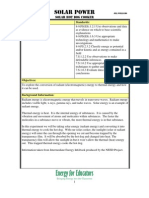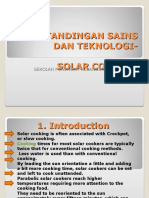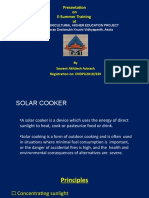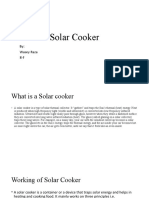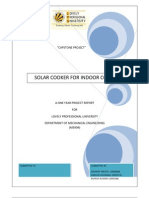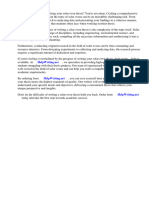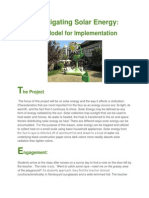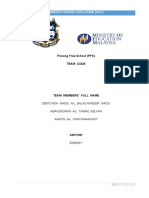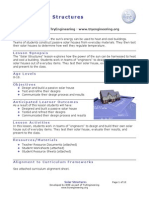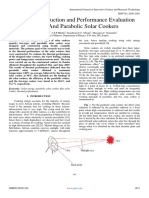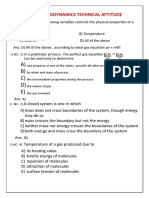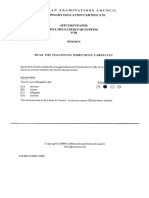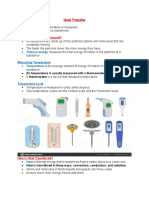Solar Energy
Solar Energy
Uploaded by
Theodore TuiningCopyright:
Available Formats
Solar Energy
Solar Energy
Uploaded by
Theodore TuiningOriginal Title
Copyright
Available Formats
Share this document
Did you find this document useful?
Is this content inappropriate?
Copyright:
Available Formats
Solar Energy
Solar Energy
Uploaded by
Theodore TuiningCopyright:
Available Formats
Understanding Solar Energy Teacher Page
What’s Cooking?
Student Objective
The student: Key Words:
• understands how the Sun’s radiation, conduction
as heat, can be captured and used convection
• given a solar oven, can explain what glazing
makes it work and how to improve insulation
on the design parabolic
• will construct a solar cooker radiation
following a given set of plans. reflector
solar collector
Materials (construction): solar thermal
• use materials list for type of cooker thermal energy
selected thermal equilibrium
• Laboratory Manual
Materials (cooking): Time:
For each group: 1 - 2 class period(s) to build oven
• oven thermometer, or thermometer 1 class for cooking
that has a range to at least 300oF
• pot holders
• disposable aluminum cooking pan
(“brownie” size works well) or clear
glass covered casserole
Background Information:
A solar cooker is a type of solar thermal collector. It “gathers” and traps the Sun’s thermal
(heat) energy. Heat is produced when high frequency light (visible and ultraviolet) is converted
into low frequency infrared radiation. Ultraviolet and visible light easily pass through glass,
however when they strike a darkened surface they are converted into long wave infrared radiation
(heat). The glass (called glazing on a solar collector) traps these long waves. For example, on a
sunny day, your car with the windows rolled up becomes a solar collector. The glass lets in the
Sun’s energy, traps the thermal energy, and the air inside your car becomes hot. As more light
enters the car, the air gets even hotter, until we say that it feels like an oven inside.
Solar cookers are improving the quality of life for many people around the world. Solar
ovens have been introduced in parts of South America, Africa, and India. In these areas, it is
typical for a woman to spend nearly half her workday looking for and collecting firewood. Also,
respiratory problems in the children of these areas have been linked to fumes created by the
burning of poor quality wood. The use of solar cookers helps to reduce the dependency on
Florida Solar Energy Center What’s Cooking? / Page 1
firewood. In addition, some women have turned their talents for building cookers into
businesses, by building and selling cookers for added income.
Besides food preparation, solar cookers can be used to purify water. This is beneficial in
areas where obtaining safe drinking water is a problem.
There are three main types of solar cookers on the market today – box, panel, and
parabolic reflector cookers.
Box cookers
Box cookers (also known as box ovens) can cook the same foods you would cook in a
standard oven or a slow cooker. As the name suggests, they have an interior chamber (“box”),
although they do not have to be square shaped. They use reflectors to concentrate more sunlight
into the box, glazing to allow sunlight into the box and then trap the heat, and insulation to retain
as much heat as possible. Commercially made box ovens can reach 400o on a clear sunny day.
Box ovens can be easily made from inexpensive or recycled materials, and are suitable for
classroom construction and cooking.
Panel cooker
Panel cookers can cook the same foods that you would cook in a covered pot on top of
the stove. They use reflectors to “grab” a larger area of sunlight and direct it towards a black
Florida Solar Energy Center What’s Cooking? / Page 2
cooking pot that is placed in a high temperature oven bag. The air inside the bag that surrounds
the pot is the insulation that retains the heat. The temperature inside the pot of a panel cooker
can reach and maintain a boiling temperature. Panel cookers can be easily made in the classroom
from inexpensive materials, and are simple to use for cooking on clear sunny days.
Parabolic reflector
Parabolic cookers produce the highest temperatures, and can be used to fry or grill food;
pot lids and cooking bags are not necessary. Parabolic cookers use reflectors to concentrate a
large amount of sunlight into a single focal point, where the temperature can reach 500o. In the
classroom, parabolic shaped cookers can be easily made from recycled satellite dishes or large
umbrellas. Although the temperature obtained with these “home made” parabolic cookers is less
than the commercial varieties, the temperature can still get very high at the focal point, so
appropriate safety should be practiced while cooking.
Procedure (prior to class)
Note: You may decide to have all the students make the same type of cooker (either
individually or in groups), or you could have different groups make different types of cookers
(and test them against each other). Three cooker plans are included in this lesson, and many
more can be found on the internet. Depending on the level of your students, you may choose to
have a completed cooker to serve as a model for the class to look at during the construction
process, or you can show the students some photos of completed cookers.
Procedure (construction day)
1. Engage: Show the Cooking in the Car video (see Internet Links sections below). Let the
students comment freely, then ask if anyone has “cooked” before using just the heat of the
Sun. (probably someone in the class has made a “not-too-successful” pizza box oven
before).
2. Tell the students that they will be building solar cookers that use the principles of
conduction, convection and insulation to make them work, and then they will be testing
their cooking capability. If necessary, review the concepts. Ask how conduction,
convection and insulation were used in the video. (convection = sun’s heat travels
through the air inside the car striking the surfaces; conduction = heat travels through the
metal of the cookie sheet to the food sitting on it; insulation = airtight car makes the air a
thermal insulator). The students should understand that all three were involved in raising
Florida Solar Energy Center What’s Cooking? / Page 3
the temperature of the food enough so that it would begin cooking. Tell the students that
in this instance the vehicle was a solar cooker....although not a great one. Ask the
students what would make a better design for a cooker. (less air space that needs to be
heated, all foods in contact with metal or conductive containers)
3. Explore: Explain the construction procedure for the cooker(s), show example(s) or
photo(s).
4. Explain common problems to avoid that would make that type of cooker not work
properly.
5. Remind students of the safety rules and the proper way to use a razor knife and any other
tools.
6. Divide the class into groups of 4 - 5 students per group (and assign cooker design if you
are doing more than one).
7. Pass out cooker plans and materials.
8. Help as needed.
9. Students should complete their Laboratory Manual pages.
Procedure (testing day)
You may decide to have students cook food, or test their cookers heating capacity using
water and save the cooking for another day/lesson.
Water test
1. Have the students put 100 mL of water in a small beaker with a thermometer placed in it.
2. Students should then “prepare” their beaker as if it was a container of food:
• Box cooker - Cut a piece of plastic wrap to cover the top of the beaker. Make a
slit in the top of the cover for the thermometer to stick out through. Secure the
cover with a rubber band.
• Panel cooker - Place the beaker and thermometer in a oven cooking bag. Close
tightly.
• Parabolic - No preparation needed for heat resistant glass. Non heat resistant
glass should be put in a metal can (or pan) painted black on the outside.
3. Students should record and graph the increase of temperature in their Laboratory Manual.
4. Explain: After the data is collected, have the groups share their results with the class and
lead a discussion. Have the students speculate on what caused the differences in heating
capabilities between cooker types, and between groups using the same cookers. The
students should be able to analyze their construction materials and ability, and come up
with ways that they could improve their designs and/or their craftsmanship.
Cooking test
You may decide to have students bring food items in from home to cook, acquire items
from the school cafeteria that they can cook in class, or purchase them. Depending on the level
of your class you could have them decide what they want to cook, or you could select something
for them that should have a high rate of success for first time solar cooks. Good first time foods
are:
• For box and panel cookers: rice mix, baked beans, fruit cobbler, canned soup (possibly
with additional ingredients), quinoa, mini cupcakes or mini muffins
• For parabolic cookers: baked beans, soup, quinoa and grilled cheese sandwiches
The best cooking times are between 10:00 and 2:00 on a clear sunny, or mostly sunny day. You
Florida Solar Energy Center What’s Cooking? / Page 4
may want to put the box cookers out in the sun before class time so they can preheat a bit.
1. Students should prepare their food according to the cooking instructions for their type of
cooker.
2. Remind those students with box cookers not to open them while cooking as this lets out
the heat.
3. Make sure all groups use pot holders.
4. Explain: After the cooking is completed, have the groups share their results (either
verbally, or with actual “tastes” of their results), and lead a discussion. Have the students
speculate on what caused the differences in cooking capabilities between cooker types,
and between groups using the same type of cookers. The students should be able to
analyze their construction materials and ability, and come up with ways that they could
improve their designs or their craftsmanship.
Evaluation and Student Assessment
Post these criteria or discuss them with your students before they begin this project. You may
use a checklist or develop a rubric for evaluation.
Activity and Teamwork: 30%
• Are the students communicating within the group?
• Are the students using critical thinking and problem solving strategies following
the lab procedures to produce valid results?
• Are the students developing the social skills needed to work as a team?
• Are the students adapting their roles and responsibilities as needed to work
effectively in their team?
Finished Cooker: 40%
• Did the cooker function properly? Was it able to trap and retain heat?
• How well is the cooker constructed?
Laboratory Manual: 10%
• Lab manual pages are complete
• Questions 5 & 6 – show understanding of the benefits of solar cooking
Problems: 20%
• Question 1 – answer includes all critical parts of a cooker, shows understanding of
how a cooker works, and is within the parameters given - 5%
• Questions 2 & 3 – answered correctly and completely - 10%
• Question 4 – answer demonstrates complete thoughts and ideas effectively - 5%
Answer Key - Problem Set
1. Answers will vary, but students should show understanding of good cooker design.
2. a) 100o C
b) 439.53 kJ
c) The water volume will decrease as the water evaporates; the temperature of the water
in the container will remain at 100o C
3. 326.586 kJ
4. Answers will vary, but students should show an understanding of the social and economic
Florida Solar Energy Center What’s Cooking? / Page 5
implications of:
• decreasing forests and associated wildlife
• health problems (and lowered life expectancy) associated with burning
wood/charcoal/dung
• impact of women spending time collecting firewood instead of contributing in
other ways to the family/society
• inability of children to attend school thus hindering the chances for them (and
society in general) to improve their standard of living
Key Words and Definitions
• conduction – the movement of heat or cold through materials that are solid
• convection – the movement of heat through fluids such as air and liquids
• glazing – the clear material (for example glass or plastic wrap) that transfers (lets in) light
and traps heat
• insulation – material used to reduce heat loss or gain
• parabolic – the set of all points whose distance from a fixed point (the focus) is equal to
its distance from a fixed line (the directrix). The algebraic graph of a quadratic equation
is a parabola. A satellite dish is an example of a parabola. In solar thermal applications,
a parabolic shape directs a large area of the Sun’s heat rays to a concentrated area.
• radiation – the way we receive heat from the Sun each day. The energy is emitted in the
form of electromagnetic waves and photons, and can move from one object to another
without heating the area in between.
• reflector – shiny device used to bounce and return (alter) the path of light
• solar collector – a device that absorbs (collects) and traps solar energy
• solar thermal – using the Sun’s energy to heat something
• thermal energy – internal energy; sum of kinetic and potential energy of random motion
of particles making up the object. Commonly thought of as “heat”.
• thermal equilibrium – state between two or more bodies where temperatures are the
same
Related Research
1. Research food preparation in other times and in other places. When, where, and how was
the Sun used in food preparation and food storage? What were the advantages and
disadvantages to the cultures of using the Sun’s energy for cooking?
2. Biomass (fuel wood) is the world’s largest source of cooking fuel. What are some of the
social, economic and environmental impacts of the widespread use of fuel wood for
cooking?
3. Cooking over an open fire is a terrible waste of energy. Several international agencies
have developed “energy efficient” ovens for cooking with wood. What do they look like
and what has prevented its widespread introduction and use?
4. Astronomer and physicist Samuel Langley is credited with the first recorded use of a solar
cooker in the United States. Research when, why, and how he used his cooker.
5. We have all heard the expression “it’s so hot you could fry an egg on the sidewalk”.
Florida Solar Energy Center What’s Cooking? / Page 6
Actually, this cannot work using just and egg and a regular sidewalk. Research the
properties of frying eggs that makes this impossible. What would you have to do to the
sidewalk, the Sun’s rays, and/or the egg to make it possible?
Related Reading
• An Outdoor Kitchen Full of Sunshine by Kris Mazy (CreateSpace Independent
Publishing, 2014)
Written by a mother of seven, who solar cooks 3 - 4 days every week, this book is a
collection of their family’s tried and true recipes.
• Cooking With Sunshine: The Complete Guide to Solar Cuisine with 150 Easy Sun-
Cooked Recipes by Lorraine Anderson and Rick Palkovic (DaCapo Press, 2006)
This book includes simple, straight-forward recipes suitable for homemade box and panel
cookers.
• Solar Cooking for Home & Camp: How to Make and Use a Solar Cooker by Linda
Frederick Yaffe (Stackpole Books, 2007)
This book written by a lifelong camper, includes instructions for building a box and a
panel cooker, easy to prepare solar recipes and great tips for solar cooking while camping.
Internet Sites:
https://www.youtube.com/watch?v=-vRj2zh2kK8
Cooking in the Car video. Humorous video of a guy trying to cook various food items on
the dash of his car to varying degrees of success. A good conversation starter, and also
good for encouraging experimentation and trial and error learning.
http://www.fsec.ucf.edu/go/energywhiz
Florida Solar Energy Center’s annual solar cooking competition, the Solar Energy Cook-
off for grades 4 through 12. Includes rules and information on how to enter a team. The
page also includes links to cookbooks of the winning student recipes from the
competition.
http://solarcooking.org/
Solar Cooking International, solar cooking archive includes solar cooking plans,
documents and a list of resources and manufacturers.
https://www.sunoven.com/basics-of-cooking-with-the-sun-a-free-interactive-online-class/
Sun Ovens International. Basics of Cooking With the Sun, free online solar cooking
class. Although this video is presented to showcase the Sun Oven (that they sell), the
video includes many helpful hints that are good for any solar cooker.
https://www.youtube.com/watch?v=YCD06MxPPrg
Weather Channel video coverage of the annual Oatman Arizona sidewalk egg frying
contest.
Florida Solar Energy Center What’s Cooking? / Page 7
Understanding Solar Energy Solar Cooker Plans
File Box Cooker
Materials
• file storage box, or other box 12" x 15" x 10"
• foil backed foam insulation board, approx. ½ sheet per oven
• plexiglass, pre-cut to 12" x 15"
• aluminum duct tape, 20 feet
• black construction paper, 12" x 15"
• aluminum foil or pieces of reflective mylar (emergency camping blanket), 18" x 21"
• scissors
• wooden dowel, stick or pencil
Procedure
1. Cut insulation material. Each oven requires:
• (1) 12" x 15"
• (2) 12" x 9 ½ "
• (2) 15" x 9 ½ "
2. Put 12" x 15" piece of insulation inside the box on the bottom.
3. Put insulation around all the walls of the inside of the box.
4. Tape all seams: bottom, sides, and around the inside top of the box with aluminum tape.
5. Cover the inside of the box lid with foil for a reflector.
6. Cover the inside bottom of the oven with black construction paper.
7. Place the glazing on the top of the oven. The glazing should sit firmly and the box should
be airtight. If not, adjust the sides.
8. Attach the box lid by one long edge to the oven with an aluminum tape “hinge”. The rod
or stick is used to adjust the tilt of this lid to capture more sunlight.
Florida Solar Energy Center What’s Cooking? / Page 8
The common problems to avoid that can cause the ovens not to seal tightly and therefore not hold
in heat:
• All seams are not sealed tightly with aluminum tape. Make sure that all the seams
are covered, both inside and around the inside top opening of the oven. The box
lid is used as a reflector, so the tape is not critical there.
• The plexiglass glazing does not sit tightly on the top of the oven. Make sure that
the top edges of the insulation are level and flat. Low spots may be filled in with
extra pieces of aluminum tape.
• Sides of boxes are squeezed in while being taped, thereby making the top opening
too small for the plexiglass to fit.
How to cook in your box cooker
1. Set the oven facing the Sun.
2. Adjust the tilt of the oven (objects can be placed under one edge), and the tilt of the
reflector (with a rod or stick) so that the Sun’s rays are directed into the body of the oven.
Sunlight should be visible on the food in the box.
3. Mix or prepare the food to be put in the cooker according to the recipe.
4. Put the food in a covered dish, or cover tightly with plastic wrap. Do not cover your food
with aluminum foil–it will reflect the sunlight away from your food. You can cook in any
non-reflective pot, however thin black metal pots work best, and shallow ones work
better than deeper ones.
5. Lift glazing, set the dish and an oven thermometer on the bottom of the oven, and replace
the glazing (you may tape around the edges of the glazing if the box is not airtight).
6. Move the cooker periodically (every 20 minutes or so) to follow the sun as it moves
across the sky.
7. When food is done, be sure to use a pot holder to remove the glazing and also the food.
Solar Cookers can get extremely hot!
Florida Solar Energy Center What’s Cooking? / Page 9
Understanding Solar Energy Solar Cooker Plans
Cook-it Style Panel Cooker
Materials
• Cook-it measurement sheet (next page)
• sheet of cardboard 48" x 36"
• mylar (from emergency “space” blanket)
• spray glue or white glue
• box cutter, scissors
• tape measure, ruler
• protractor
Procedure
1. Using the measurement sheet, draw the cooker lines and fold lines onto the sheet of
cardboard.
2. Cut out the cooker along the cutting lines. Fold the cardboard along the fold lines (Hint:
It is easier to get a straight fold line if you firmly hold a yard stick or other straight edge
along the fold line and then fold the other side up against the straight edge)
3. Affix the mylar to the side of the cooker that is on the inside of your folds. If using spray
glue, spray the glue onto the cardboard and then place the mylar on top pressing out as
many bubbles and creases as possible (a rubber roller or a plastic card–credit card,
driver’s license, etc–can be helpful). If you are using white glue, thin the glue until it
spreads easily with a paint brush.
4. Trim the mylar around the edges of the cooker.
5. Cut the two slits.
How to cook using your panel cooker
1. Set up the cooker and place it facing the Sun.
2. Mix or prepare the food to be put in the cooker according to the
recipe.
3. Put the food in a covered black pot and put the whole dish in a high
temperature baking bag. Seal tightly. Do not cover your food/pot with aluminum foil–it
will reflect the sunlight away from your food.
4. If you do not have a black pot, you can paint the outside of a pot or canning jar black with
paint designed for barbeque grills.
5. Place the pot in the center of the cooker. Move the cooker periodically (every 20
minutes or so) to follow the Sun as it (appears to) move across the sky.
6. When food is done, be sure to use a pot holder to remove the pot. Solar Cookers can get
extremely hot!
Florida Solar Energy Center What’s Cooking? / Page 10
Cook-it measurements
Florida Solar Energy Center What’s Cooking? / Page 11
Understanding Solar Energy Solar Cooker Plans
Umbrella Parabolic Cooker
Materials
• large umbrella (min 120 cm diameter)
• mylar (from camping/emergency “space” blanket)
• aluminum duct tape
• craft paper
• spray glue or white glue
• scissors
• hacksaw
• stand to hold the pot--metal plant stand, small tripod, etc.
Procedure
1. Open umbrella. Using the craft paper, make a template of one of the triangular sections
of the inside of the umbrella.
2. Using the template you made, trace enough sections onto the mylar to cover the inside of
your umbrella. Cut out the sections.
3. Working outdoors or in a very well ventilated area, affix one section at a time to the
inside of the umbrella with the spray glue (spraying the umbrella and then placing the
mylar pieces). Press out as many bubbles and creases as possible (a rubber roller or a
plastic card–credit card, driver’s license, etc.–can be helpful). If you are using white glue,
thin the glue until it spreads easily with a paint brush.
4. Tape around the outside edges with aluminum tape.
5. Tape any loose or uncovered seams between sections with aluminum tape.
6. To trim the stick and handle at the focal point for the pot stand, take the umbrella outside
on a sunny day. Place the umbrella on the ground and point the stick directly at the sun.
Mark the spot on the handle where the reflection of the sun’s rays is the greatest.
7. Cut the stick 3" below your mark (shorter). This will enable you to place your pot in the
focal point of the umbrella.
8. When cooking, your cooker will sit on the ground facing the Sun. You may need to place
something behind your cooker to keep it pointed towards the Sun.
9. You want the bottom of your pot to be positioned in the focal point (3" above the top of
your stick), so the pot stand or tripod will need to sit on top of part of the cooker. Make
small cuts with the scissors so the legs can go through the cooker and sit firmly on the
ground below.
How to cook using your parabolic cooker
1. Mix or prepare the food to be put in the cooker according to the recipe.
2. Position the cooker so the face of the umbrella is pointing directly at the Sun. Position
your pot stand so the pot will be in the focal point. Remember, whatever is in the focal
Florida Solar Energy Center What’s Cooking? / Page 12
point of your cooker will get extremely hot! It is also recommended that you wear
sunglasses while working with a parabolic cooker.
3. Place your food in your cooking pot or pan; open frying pans may be used with parabolic
cookers.
4. Place the cooking pan on the pot stand. Be sure to watch your food–it can burn with a
parabolic cooker.
5. For extended cooking, move the cooker periodically (every 10 minutes or so) to follow
the sun as it moves across the sky.
Florida Solar Energy Center What’s Cooking? / Page 13
Understanding Solar Energy Cooking Tips
What’s Cooking?
Cooking Tips - Box Ovens
1. Any recipe that would be suitable for a conventional oven will work in a box oven; also
crock pot recipes are suitable for a box cooker.
2. Foods generally use less liquids or cook in their own juices. This produces better tasting
and more nutritious food.
3. Foods never burn and rarely overcook in a solar oven.
4. When cooking foods containing liquids, use lids on pans, cover tightly with plastic wrap,
or use cooking bags to avoid condensation on the oven glass which blocks the solar
radiation.
5. Don’t open your box cooker unless absolutely necessary. Every time you do, you let out
the heat and slow down the cooking process.
6. Use a meat thermometer instead of a timer to determine if the food is done.
7. A Lazy Susan underneath your box oven can help you rotate it easily to follow the Sun.
Remember to adjust your box cooker every 20 minutes or so.
8. Foods particularly suited for the classroom include: hot dogs, slice and bake cookies,
brownies, rice mixes, cocktail sausages in barbeque sauce, nachos, baked apples, kebobs,
soup, baked beans, quinoa, mini cupcakes and mini muffins.
9. Some specific food tips:
• Cook (steam) yellow and green vegetable in dark colored casseroles to prevent
discoloration.
• Vegetables and meats can be cooked with no water or added liquid
• Reduce liquids in cake recipes by one half.
• Cook foods in their natural state (i.e. potatoes in skins and corn in husks).
• Sprinkle some cinnamon on the top of baked goods to darken the surface.
• Doughs and batters containing eggs and milk will brown easier.
• Chewy dessert recipes such as brownies come out better than crispy ones.
• Meats cook better if cut into small pieces.
• If the recipe calls for the addition of oil, try adding it last, so that it floats on the
top. This decreases the amount of evaporation (thereby decreasing the amount of
heat loss). Stir in the oil at the end.
Temperature:
• On a clear and sunny day, a box oven will heat up to 250oF and above. On these
days you can cook or bake anything.
• On a partially cloudy day, the oven will heat to 200oF to 250oF. On these days you
can easily cook meats, rice, baked potatoes, and frozen vegetables, but baking is
not recommended.
• On a partially cloudy day, adjust your cooking time to account for the lower
temperature. A rule of thumb is to figure twice the regular cooking time.
Florida Solar Energy Center What’s Cooking? / Page 14
Cooking Tips - Panel Cookers
1. Most recipes that can be cooked on top of the stove without frequent stirring will work
with a panel cooker. Crock-pot recipes will also work well.
2. Always use lids on pans and place the whole pan in a tightly closed high temperature
oven bag. Thin, shallow, aluminum or steel pans will heat faster.
3. Foods generally use less liquids or cook in their own juices. This produces better tasting
and more nutritious food.
4. Foods never burn and rarely overcook in a panel cooker.
5. Use a meat thermometer instead of a timer to determine if the food is done.
6. A Lazy Susan underneath your panel cooker can help you rotate it easily to follow the
Sun. Remember to adjust your panel cooker every 20 minutes or so.
7. Foods particularly suited for the classroom include: rice mixes, chili, chowder, stew,
baked beans, couscous
8. Some specific food tips:
• Cook (steam) yellow and green vegetables in dark colored casseroles to prevent
discoloration.
• Vegetables and meats can be cooked with no water or added liquid.
• Meats cook better if cut into small pieces.
Temperature:
• On a clear and sunny day, a panel cooker will heat the contents to boiling for a
sustained time. On these days you can cook anything.
• On a partially cloudy day, the panel cooker will heat the contents above
pasteurization temperature (149oF), and probably to boiling. On these days you
can easily cook most things, but extra care should be taken with meats (check the
temperature).
• On a partially cloudy day, adjust your cooking time to account for the lower
temperature. A rule of thumb is to figure twice the regular cooking time.
Cooking Tips - Parabolic Cookers
1. Most recipes that can be cooked on top of the stove, in a frying pan or on a grill can be
cooked with a parabolic cooker. Foods will brown with a parabolic cooker.
2. Always use heavy metal pans. Do not use high temperature baking bags. Lids on pots
are not necessary, but may be desired for some recipes that need additional heat to melt
something (i.e. grilled cheese sandwiches).
3. Be mindful of observers that don’t know the power of solar cooking–they can get burned
easily just because they don’t realize how hot the focal point of a parabola can get.
4. Foods particularly suited for the classroom include: hot dogs, hamburgers, kebobs, grilled
vegetables, grilled cheese sandwiches, stir fry, bacon.
5. Some specific food tips:
• Keep an eye on your food! Parabolic cookers can get very hot, and also tend to
cook in only one area–you may need to turn or rotate your food. Cast iron
cookware can help to spread out the heat.
• Unlike other solar cookers, parabolic cookers can burn food. Conversely, if your
food is not cooking you probably don’t have your pan in the focal point.
Florida Solar Energy Center What’s Cooking? / Page 15
Temperature:
• On a clear sunny day a parabolic cooker can reach 500oF at its focal point. On
these days you can cook anything–and cook it quickly!
• On a partially cloudy day a parabolic cooker’s temperature will vary with the
cloud cover. Cooking will take a little longer.
Florida Solar Energy Center What’s Cooking? / Page 16
Understanding Solar Energy Recipes
What’s Cooking?
Recipes
The following recipes were student created and prepared for the Solar Energy Cook-Off as part
of the EnergyWhiz annual competition held at the Florida Solar Energy Center. More
information about the event and many more award winning solar recipes can be found at:
http://www.fsec.ucf.edu/go/solarcookoff
Grandma’s Italian Wedding Soup
Suitable for all cookers
st
1 Place Elementary Division, 2012
2 cups chicken stock
6 frozen mini meatballs
½ cup orzo
Basil, oregano, parsley and garlic to taste
Salt and pepper to taste
20 baby spinach leaves
Mix chicken stock, meatballs, orzo, herbs and garlic together in a dutch oven or similar pot.
Place pot in cooker. Simmer for 1 hour (if using a parabolic cooker, stir frequently and cook for
less time). Meanwhile wash the spinach leaves thoroughly, pat dry, then shred into thin strips.
Add spinach, salt and pepper and simmer for another 20 minutes.
Creamy Potato Soup
Suitable for all cookers
1st Place Middle Division, 2013
1 lb Yukon potatoes (smaller ones are best)
2 packages pre-cooked bacon, crumbled
1 Tablespoon butter
1 cup green onions, sliced
1 can (10½ oz) chicken broth
2 cups water
½ cup instant mashed potato granules
2 cups Gruyere cheese, finely grated
½ teaspoon salt
1/4 teaspoon pepper
2 cups heavy cream
Florida Solar Energy Center What’s Cooking? / Page 17
Bake potatoes in cooker until tender (Box cooker - place potatoes directly in cooker; Panel
cooker - put in high temperature bag; Parabolic - put in covered pot with 1/4" water). Cut into
small cubes and set aside. Melt butter, add onions and one package bacon crumbles. Place in
cooker until onion is tender. Add chicken broth and water, bring to boil. Remove from cooker
and gradually stir in instant potatoes, blending until smooth. Add salt, pepper, cheese and
reserved baked potatoes; stir. Place back in cooker until cheese is melted. Stir in cream. Serve
garnished with bacon crumbles.
All-American French Cassoulet
Suitable for box and panel cookers
1st Place Middle School Division, 2009
1 can great northern white beans, or cannelini beans
1 lb lamb, cut in 3/4" pieces
1 lb beef rib meat, cut off the bone, cut in 3/4" pieces
1 lb thick cut hickory smoked bacon
1 lb garlic & herb flavored sausage, cut in 1" pieces
1 bouquet garni with any of your favorite fresh herbs (team used fresh sage and thyme)
1 cup grape tomatoes, cut in half
1 cup carrots, cut small
4 - 5 cloves garlic, minced
1 can beef gravy
Finishing salt
10 - 12 homemade crostini for garnish
Sage leaves for garnish
Precook (or use parabolic): Pan sear all sides of the lamb and beef. Do not cook meat–meat will
fully cook in the casserole to release flavor into the sauce.
Layer in a casserole dish–beans, garlic, bouquet garni, carrots and tomatoes. Then place all
meats on top except the bacon. Place casserole in solar cooker. Cook in solar cooker for 3
hours. Cook bacon separately in solar cooker, then drain and chop. When serving, remove
bouquet garni. Garnish each plate with finishing salt, then spoon cassoulet on top. Sprinkle with
bacon and garnish with a crostini on the corner of each plate and a sage leaf on the side.
Baked Tilapia with Coconut-Cilantro Sauce
Suitable for box cookers
st
1 Place High School Division, 2013
Canola oil spray
(4) 6 oz pieces tilapia filet
1/4 teaspoon kosher salt, plus more for seasoning
½ cup light reduced-fat coconut milk
½ cup cilantro leaves, plus more for garnish
Florida Solar Energy Center What’s Cooking? / Page 18
1 teaspoon peeled, chopped fresh ginger
½ teaspoon garam masala
2 garlic cloves
½ jalapeno pepper, seeded and chopped
Spray a baking pan with oil spray. Place fish in pan and sprinkle with salt and pepper. Combine
coconut milk and remaining ingredients in a blender and pulse until fairly smooth. Pour the
coconut mixture over the fish. Bake until the fish is just opaque in the cneter, about 15 minutes.
Garnish with more cilantro and serve. (Note: Garam masala is a popular spice from India. It is
available at specialty stores and some grocery stores.)
Mahi Mahi Soft Tacos
Suitable for parabolic cookers
1st Place High School Division, 2012
4 mahi-mahi filets
2 Tablespoons butter, melted
1½ cups tomato, chopped
1/4 cup red onion, finely chopped
1 jalepeno, finely chopped
3 cloves garlic, minced
Juice of ½ lime
½ head lettuce, chopped
8 flour tortillas
Grill fish on both sides, brushing with butter (approx. 20 minutes). Combine tomatoes, onion,
jalapeno, garlic and lime. When fish is done in the center, flake with a fork. Set aside and keep
warm. Lightly grill the tortillas in a cast iron skillet until they are warm and brown. Layer fish,
lettuce and pico de gallo on tortilla. Roll.
Lemon Cupcakes with Strawberries
Suitable for box cookers
1st Place Elementary Division, 2014
1/4 cup softened butter
Heaping 1/4 cup sugar
Rind of 1/4 lemon, grated
1 egg
½ teaspoon vanilla extract
½ cup flour
½ Tablespoon milk
½ cup sliced strawberries
Whipped cream
Orange slices for garnish
Florida Solar Energy Center What’s Cooking? / Page 19
Combine butter, sugar and lemon rind. Mix well with a wooden spoon until fluffy. Gradually
beat in egg and vanilla. Mix in flour until combined. Add milk and mix well. Cupcake batter
should have a smooth consistency. Cook for 40 - 45 minutes at 200o . Let cupcakes cool. Cut
the cupcakes in half (horizontally) and sandwich the strawberry slices with a dollop of whipped
cream in between the cupcake layers. Top cupcake with whipped cream. Garnish plate with
strawberry slices and orange slice. Enjoy!
Chocolate Bread Pudding
Suitable for box cookers
st
1 Place Middle School Division, 2013
4 large stale chocolate muffins, broken into small pieces
2 cups cream
4 eggs
2 Tablespoons butter
6 large strawberries, washed and dried
1 cup melting chocolate
Whipped cream
½ cup strawberry preserves
1 teaspoon honey
Set up oven and let it preheat. Meanwhile, slightly beat eggs and cream in a bowl. Blend in
muffin pieces and allow to sit for 30 minutes (put in cooler). Butter pan or spray with cooking
spray. Put muffin mixture in pan. Cover and bake until set in center (1 - 1½ hours depending on
weather). Meanwhile, put chocolate in a small pan and put in oven, let chocolate melt. Dip
strawberries into chocolate. Chill on waxed paper in cooler. Place strawberry preserves in
another small pan, heat in oven until runny. Add water, stir; add honey, stir. To serve, put a
swish of sauce on plate, top with a slice of bread pudding and garnish with chocolate covered
strawberry.
Florida Solar Energy Center What’s Cooking? / Page 20
Understanding Solar Energy Florida and National Standards
Next Generation Science & Common Core
What’s Cooking?
Florida NGSS Standards & Related Subject Common Core
1 2 3 4 5 6 7 8 9 1 1 1 1 1 1 1 1 1 1 2
0 1 2 3 4 5 6 7 8 9 0
Nature of Science
Standard 4 SC.912.N.4 X
Earth and Space
Standard 6 SC.912.E.6. X
Physical Science
Standard 10 SC.912.P.10. X X
Life Science
Standard 17 SC.912.L.17. X
M athematics Standards MAFS.912.N-Q.1.1, MAFS.912.N-Q.1.2, MAFS.912.N-Q.1.3, MAFS.912.A-REI.2.3
Science–Standard 4: Science and Society
• SC.912.N.4.2 - Weigh the merits of alternative strategies for solving a specific societal
problem by comparing a number of different costs and benefits, such as human,
economic, and environmental.
Science–Standard 6: Earth Structures
• SC.912.E 6.6 - Analyze past, present, and potential future consequences to the
environment resulting from various energy production technologies.
Science–Standard 10: Energy
• SC.912.P.10.1 - Differentiate among the various forms of energy and recognize that they
can be transformed from one form to others.
• SC.912.P.10.4 - Describe heat as the energy transferred by convection, conduction, and
radiation, and explain the connection of heat to change in temperature or state of matter.
Science–Standard 17: Interdependence
• SC.912.L.17.17 - Assess the effectiveness of innovative methods of protecting the
environment.
Mathematics–Number & Quantity
• MAFS.912.N-Q.1.1 - Use units as a way to understand problems and to guide the solution
of multi-step problems; choose and interpret units consistently in formulas; choose and
interpret the scale and the origin in graphs and data displays.
• MAFS.912.N-Q.1.2 - Define appropriate quantities for the purpose of descriptive
modeling.
Florida Solar Energy Center What’s Cooking? / Page 21
• MAFS.912.N-Q.1.3 - Choose a level of accuracy appropriate to limitations on
measurement when reporting quantities.
Mathematics–Algebra
• MAFS.912.A-REI.2.3 - Solve linear equations and inequalities in one variable, including
equations with coefficients represented by letters.
National Next Generation Science Standards
Energy
• HS-PS3-3 - Design, build, and refine a device that works within given constraints to
convert one form of energy into another form of energy.
Engineering Design
• HS-ETS1-1 - Analyze a major global challenge to specify qualitative and quantitative
criteria and constraints for solutions that account for societal needs and wants.
• HS-ETS1-2 - Design a solution to a complex real-world problem by breaking it down into
smaller, more manageable problems that can be solved through engineering.
Note: Related Common Core Mathematic Standards are listed in the Florida section above.
Florida Solar Energy Center What’s Cooking? / Page 22
Understanding Solar Energy Laboratory Manual
What’s Cooking?
1. In the space below, draw a diagram of your solar cooker and label its parts.
2. Explain the functions of each of the parts labeled above.
3. What was the highest temperature you observed in your cooker?
If you are testing your cooker with a beaker containing 100 mL of water record your data below:
Time Temperature
Start
After 5 min
10 min
15 min
20 min
Florida Solar Energy Center What’s Cooking? / Page 23
25 min
30 min
35 min
4. Graph your results below.
5. What are some advantages and disadvantages to using a solar cooker?
6. What are some other applications for solar cookers? (Hint: think about
recreational/weekend activities or after a hurricane)
Florida Solar Energy Center What’s Cooking? / Page 24
Understanding Solar Energy Problems
What’s Cooking7?.
1. You are an engineer contracted by a foreign agency to design a solar oven that is easy to
use and economical for the local economy to build. The parameters to follow are:
• It must not weigh more than 40 lbs.
• It must not cost more than $50. to build (assume that this country’s prices for
construction materials are roughly the same as ours).
• It must reach temperatures high enough to cook meat and purify water.
• It must be able to stay outside in inclement weather without falling apart.
Draw a diagram of your design, list your parts and an approximate cost of each.
Florida Solar Energy Center What’s Cooking? / Page 25
2. 1.5 kg of 30o C water is placed in a solar oven. After 30 minutes in the sun the water
begins to boil.
a) What temperature is the water?
b) What is the amount of heat that has been added to the water to raise it to the
boiling point? Hint: use the formula Heat gain/loss = mass ( Q Î T ), where Q
is the specific heat of a substance. The specific heat of water is 4180 J/kg @ K
c) If the water remains in the oven in direct sun, how will the water’s temperature
and volume change? How much will the temperature of the water rise?
3. You place 1 kg of 20o C water in your oven. After 15 minutes, the temperature of the
water is 98o C. How much heat has been added to the water?
4. In some areas of the world where people cook by wood, women and their children spend
up to 70% of their time gathering firewood. How would a solar oven improve their lives?
Include economic, health, societal benefits as well as the general standard of living for the
individuals.
Florida Solar Energy Center What’s Cooking? / Page 26
You might also like
- Shoebox Solar CookerDocument12 pagesShoebox Solar Cookermaya asih rohaeniNo ratings yet
- sm2 Whats-Cooking 1Document8 pagessm2 Whats-Cooking 1api-446087210No ratings yet
- Solar Oven Design Brief 8Document5 pagesSolar Oven Design Brief 8api-451196421No ratings yet
- Literature Review On Parabolic Solar CookerDocument8 pagesLiterature Review On Parabolic Solar Cookerc5rz37qv100% (1)
- Project Report On Test Rig For Solar CookerDocument33 pagesProject Report On Test Rig For Solar CookerAkshay BhilareNo ratings yet
- Literature Review of Solar Box CookerDocument7 pagesLiterature Review of Solar Box Cookerc5e4jfpn100% (1)
- Solar Panel Pizza Oven TaskDocument2 pagesSolar Panel Pizza Oven Taskapi-450931716No ratings yet
- Introduction To Solar CookingDocument29 pagesIntroduction To Solar CookingNurul Shafiah Mustafa KamalNo ratings yet
- Literature Review On Solar OvenDocument5 pagesLiterature Review On Solar Ovenaflsmyebk100% (1)
- Solar Cooker Thesis PDFDocument8 pagesSolar Cooker Thesis PDFfjdqvrcy100% (2)
- 305 Lesson 5Document6 pages305 Lesson 5api-486543867No ratings yet
- Solar Energy 4 - Hot Dog CookerDocument7 pagesSolar Energy 4 - Hot Dog CookerabrahammansouriNo ratings yet
- Solar Cooker ThesisDocument4 pagesSolar Cooker Thesisjenniferriveraerie100% (2)
- Alkaf Powerpoint 001Document20 pagesAlkaf Powerpoint 001hazem hadeNo ratings yet
- Solar Cooking Presentation SMK s2 2015Document13 pagesSolar Cooking Presentation SMK s2 2015samtajsbNo ratings yet
- FN Hardman MicrowaveMagic1Document21 pagesFN Hardman MicrowaveMagic1akhilsahu2004No ratings yet
- Solar Cooker: Eminar ResentationDocument28 pagesSolar Cooker: Eminar ResentationUtkarsh PandeyNo ratings yet
- Green Cooker Challenge UpdatedDocument22 pagesGreen Cooker Challenge UpdatedNurul Shafiah Mustafa Kamal0% (1)
- Introduction Solar CookerDocument16 pagesIntroduction Solar CookerpratishNo ratings yet
- Design BriefDocument5 pagesDesign Briefapi-483392589No ratings yet
- Solar CookerDocument6 pagesSolar Cookerjeff whoNo ratings yet
- Solar Cooker 1Document44 pagesSolar Cooker 1devilgamer532007No ratings yet
- Unit 2 Solar CookersDocument27 pagesUnit 2 Solar Cookersswapnil.mahajan7273No ratings yet
- Solar Oven Lesson PlanDocument2 pagesSolar Oven Lesson Planapi-241104988No ratings yet
- Pizza Box PlansDocument11 pagesPizza Box PlansNasreen KhanNo ratings yet
- SolarcookerDocument27 pagesSolarcookerishitahumnabadkar43No ratings yet
- Solar Activities For StudentsDocument6 pagesSolar Activities For Studentsslv_prasaadNo ratings yet
- Grade VII PBL (SCIENCE) .Docx - 20240703 - 210809 - 0000Document2 pagesGrade VII PBL (SCIENCE) .Docx - 20240703 - 210809 - 0000jasharsh2007No ratings yet
- Solar OvenDocument5 pagesSolar Ovenlink head0% (1)
- SeminarDocument15 pagesSeminarARIHANT SAWANTNo ratings yet
- Solar CookerDocument13 pagesSolar CookerMayank Dubey100% (2)
- Investigatory ProjectDocument10 pagesInvestigatory ProjectLance jovenNo ratings yet
- Solar Cooker: By: Wasey Raza 8-FDocument7 pagesSolar Cooker: By: Wasey Raza 8-FWasey RazaNo ratings yet
- FeasibilityDocument16 pagesFeasibilityRavi TejaNo ratings yet
- MMM MM: MMMMMMMMMMMMMMMMMMMMMMMMMMMMMMMMMMMMMMMMMMMMMMM MDocument15 pagesMMM MM: MMMMMMMMMMMMMMMMMMMMMMMMMMMMMMMMMMMMMMMMMMMMMMM MNishant MehtaNo ratings yet
- Solar Oven ThesisDocument6 pagesSolar Oven Thesisjessicabriggsomaha100% (2)
- Types of Solar CookersDocument3 pagesTypes of Solar CookersMartinho Moco OelNo ratings yet
- Solar Cooker - EngDocument9 pagesSolar Cooker - EngcintautamaNo ratings yet
- Unit 5 Insulation Teacher Lab Pages FINALDocument6 pagesUnit 5 Insulation Teacher Lab Pages FINALAlice Lin100% (1)
- Heat Retention Solar OvenDocument14 pagesHeat Retention Solar OvenMusrady MulyadiNo ratings yet
- Solar CookerDocument26 pagesSolar Cookerd4rkrakeshNo ratings yet
- Design Thinking 2Document1 pageDesign Thinking 2Raj EshNo ratings yet
- Efficiency Energy Cooking CompetitionDocument19 pagesEfficiency Energy Cooking CompetitionWan Muhammad TarmiziNo ratings yet
- Solar Cooking PackDocument10 pagesSolar Cooking PackTony MorerwaNo ratings yet
- Study Solar CookerDocument3 pagesStudy Solar CookerSreo Sree Roy ʘ‿ʘNo ratings yet
- Calorie Lesson PlanDocument5 pagesCalorie Lesson Planapi-316338270No ratings yet
- Capturing HeatDocument35 pagesCapturing HeatcagedraptorNo ratings yet
- Investigating Solar EnergyDocument5 pagesInvestigating Solar Energyapi-251642500No ratings yet
- Unit 4 Part 2 Solar EnergyDocument11 pagesUnit 4 Part 2 Solar EnergySruthy SabanthNo ratings yet
- E7 Exploring Passive Solar Energy and Our ClassroomDocument4 pagesE7 Exploring Passive Solar Energy and Our Classroomapi-249625870No ratings yet
- 1 Solar CookersDocument14 pages1 Solar CookersShyloo GsaNo ratings yet
- Green Cooker Challenge (GCC) : Penang Free School (PFS) Team CodeDocument11 pagesGreen Cooker Challenge (GCC) : Penang Free School (PFS) Team CodeSentoash NaiduNo ratings yet
- EDITED Thermal Physics Task-3 MYP-4 1Document3 pagesEDITED Thermal Physics Task-3 MYP-4 1Hazaiz SulaimanNo ratings yet
- Principles of Solar Box Cooker DesignDocument17 pagesPrinciples of Solar Box Cooker Designglobalrevolution75% (4)
- 005-001-000-027 Solar StructuresDocument10 pages005-001-000-027 Solar StructuresBalian1908No ratings yet
- Design, Construction and Performance Evaluation of Box and Parabolic Solar CookersDocument7 pagesDesign, Construction and Performance Evaluation of Box and Parabolic Solar CookersInternational Journal of Innovative Science and Research TechnologyNo ratings yet
- Investigatory Project - OpticsDocument14 pagesInvestigatory Project - OpticsKenneth Karl Pilapil50% (2)
- Why Solar Cooker Student Reading PreapDocument5 pagesWhy Solar Cooker Student Reading Preapapi-288765501No ratings yet
- Solar Cooking for Home & Camp: How to Make and Use a Solar CookerFrom EverandSolar Cooking for Home & Camp: How to Make and Use a Solar CookerRating: 4.5 out of 5 stars4.5/5 (3)
- Fluent HeatTransfer L01 Introduction PDFDocument50 pagesFluent HeatTransfer L01 Introduction PDFHoNo ratings yet
- Heat TransferDocument99 pagesHeat TransferAnonymous M5wAP86100% (2)
- Module23 - Consequence Analysis - Impact CriteriaDocument32 pagesModule23 - Consequence Analysis - Impact CriteriaMinh ThưNo ratings yet
- Iso 13943 2017Document15 pagesIso 13943 2017Mursid SispamuntraNo ratings yet
- Design and Model of Flat Plate Solar Collector For Water HeatingDocument137 pagesDesign and Model of Flat Plate Solar Collector For Water Heatingnigus gereziher100% (3)
- A) B) C) D) E) : Thermodynamics Technical AptitudeDocument11 pagesA) B) C) D) E) : Thermodynamics Technical AptitudeAvinash GateNo ratings yet
- Flaresim - Flare SystemDocument2 pagesFlaresim - Flare SystemJeEJyZaNo ratings yet
- 6035 L2u203 PPT Outcome4Document9 pages6035 L2u203 PPT Outcome4shahin.noktehdan4102No ratings yet
- Heat Transfer Equation Sheet: K A H ADocument31 pagesHeat Transfer Equation Sheet: K A H ABeydaNo ratings yet
- 2008 CSEC Physics Specimen P1Document14 pages2008 CSEC Physics Specimen P1AyanaNurseNo ratings yet
- Theoretical Analysis of Overall Heat Loss Coefficient in A Flat Plate Solar Collector With An In-Built Energy Storage Using A Phase Change MaterialDocument10 pagesTheoretical Analysis of Overall Heat Loss Coefficient in A Flat Plate Solar Collector With An In-Built Energy Storage Using A Phase Change MaterialPranav OmkarNo ratings yet
- Thermal Remote SensingDocument16 pagesThermal Remote SensingAkhilesh SinghNo ratings yet
- Natural Cooling Systems of Jaisalmer: Vinod GuptaDocument7 pagesNatural Cooling Systems of Jaisalmer: Vinod GuptaMALLIMPATTINo ratings yet
- Instant Access to An Introduction to Transport Phenomena in Materials Engineering 3rd Edition Gaskell ebook Full ChaptersDocument62 pagesInstant Access to An Introduction to Transport Phenomena in Materials Engineering 3rd Edition Gaskell ebook Full Chaptershannaygreif100% (1)
- Heat Energy (11-16) PDFDocument24 pagesHeat Energy (11-16) PDFcapricorn cassoNo ratings yet
- Expt 3 FinalDocument8 pagesExpt 3 FinalJV CustodioNo ratings yet
- Heat Transfer - G6 Lesson NotesDocument3 pagesHeat Transfer - G6 Lesson NotesJung Ahn HongNo ratings yet
- Abubakar Et Al., (2017) - A Review of Geothermal Mapping Techniques Using Remotely Sensed Data.Document11 pagesAbubakar Et Al., (2017) - A Review of Geothermal Mapping Techniques Using Remotely Sensed Data.Mario Alejandro Cordoba RuizNo ratings yet
- Physics Investigatory Project On Ir Based Security SystemDocument15 pagesPhysics Investigatory Project On Ir Based Security SystemSudarshanNo ratings yet
- Experiment - 4: AIM: To Measure The Emissivity of Test PlateDocument8 pagesExperiment - 4: AIM: To Measure The Emissivity of Test PlateRushabh PatelNo ratings yet
- Sustainable Roofs For Warm Humid Climates - A Case Study in Residential Buildings in Madurai, Tamilnadu, IndiaDocument14 pagesSustainable Roofs For Warm Humid Climates - A Case Study in Residential Buildings in Madurai, Tamilnadu, Indiamadhu100% (1)
- Advances in Heat Transfer Augmentation Techniques in Single Phase-2024Document309 pagesAdvances in Heat Transfer Augmentation Techniques in Single Phase-2024Bunner Fast100% (1)
- A Computational Model For The Prediction of Steel HardenabilityDocument12 pagesA Computational Model For The Prediction of Steel HardenabilityfdcarazoNo ratings yet
- Chapter 11. Fundamental of RadiationDocument29 pagesChapter 11. Fundamental of RadiationDayanidiNo ratings yet
- Book Thermometry PDFDocument147 pagesBook Thermometry PDFeisemheimNo ratings yet
- Cryogenic Fluid Storage & Transfer Systems: Module 5: Cryogenic Engineering ME 467Document33 pagesCryogenic Fluid Storage & Transfer Systems: Module 5: Cryogenic Engineering ME 467meeraNo ratings yet
- RadiationDocument2 pagesRadiationralona2648No ratings yet
- An Example of Verification, Validation, and Reporting of Indoor Environment CFD Analyses (RP-1133)Document17 pagesAn Example of Verification, Validation, and Reporting of Indoor Environment CFD Analyses (RP-1133)Bharath kumarNo ratings yet
- Cheat Sheet 101 2.0Document10 pagesCheat Sheet 101 2.0john_42494No ratings yet
- HeatDocument7 pagesHeatkevinjorgeramosNo ratings yet











